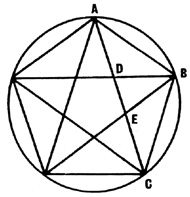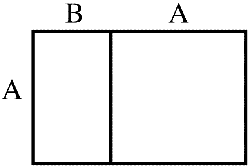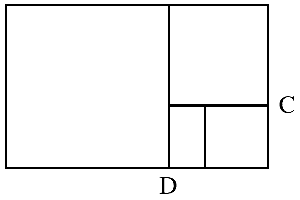 |
||
 |
|||||
| Buy the Heart of Empire Directors Cut through PayPal for just £4.99 | |
Page 31
This page is a little word-heavy but otherwise it meant either cramming extra frames in the previous pages or spreading this over three pages to keep the cat's death hidden after the following spread.
Planets: this was indeed the alignment of the planets at Arkwright's birth in 1953, worked out by an astrologer for The Adventures of Luther Arkwright. This time round I've avoided giving the year of the setting so as not to date the story.
"Many astrologers"etc.: this also was true.
The Golden Section and the Fibonacci sequence
Are you ready for this?
The Golden Section, the Divine Proportion or the Golden Number is a ratio observable in nature, art and mathematics. It is 1.618.
I.618 has always been
considered an important number and has the mathematical name ![]() (or
"Fie"). If you divide 1 by fie symbol you get
0.618. If you multiply Fie by itself you get 2.618. Wacky, huh?
But it gets better. Check out the pentagram below, oft used in magick,
and the pentagon sacred to the Ancient Greeks.
(or
"Fie"). If you divide 1 by fie symbol you get
0.618. If you multiply Fie by itself you get 2.618. Wacky, huh?
But it gets better. Check out the pentagram below, oft used in magick,
and the pentagon sacred to the Ancient Greeks.
 |
In the pentagon there is a Golden Section relationship between any diagonal and any side of the pentagon. AC:AB = Fie. All the diagonals intersect each other according to Fie, so that AD:DE= Fie and CE:ED=Fie. Where this becomes very interesting is when it's applied to human perception. It appears that we all find forms containing the Golden Section harmonious and pleasing to the eye. When shown a range of rectangles, all of differing proportions, and asked to choose the one with the most perfect shape, the one with the greatest harmony between one side and the other, (unless one's aesthetically challenged) we will inevitably choose the Fie rectangle.
Here it is; |
|
In this rectangle, the ratio between the two sides A:B is 1:1.618 If you then construct a square, using the longest side, and add it to the rectangle, you get a new, bigger Fie rectangle. A:B = (A+B):C |
|
 |
If you add another square with sides the same as the longest side of the second rectangle, you get a bigger Fie rectangle, (A+B):C = C:D and so on ad infinitum. We're talking mandelbrot patterns, fractals. This doesn't happen if you try it with rectangles of a different proportion. |
|
The thing is, Fie appears in nature; in the swirls of shells, the limbs of trees, pine cones, daisy petals and in ourselves and animals. Look at your arm: on average the proportion of your upper arm to your lower arm is Fie, as is your lower arm to your hand, your hand to your fingers, each joint of your fingers to the one following. It's literally in your face. It's in horses, cows, sheep. It's not an invention, a theory applied to nature: it exists. Fie is out there! |
|
Which, presumably, is why we find it pleasing in the first place and why the artists of the Renaissance named it the Divine Proportion and applied it to all their work. It's still used in architecture, consciously or intuitively, to give pleasing proportions to our human perceptions.
Appropriately enough, it is the standard proportions of an American comicbook page.
The mathematical sequence, The Fibonnacci Series, goes like this: 1 1 2 3 5 8 13 21 34 55 89 144 and so on. Each number is the sum of the two which precede it. This also follows patterns in nature: sunflower seeds, trees etc. The higher you go with this sequence, the more it conforms with the Golden Section (eg 144 divided by 89 = 1.6179).
5 and the 23 enigma
Five has long been regarded as a magical number (see pentagram above showing how it conforms with the Divine Proportion). It is the human microcosm; the number of humanity forming a pentagon with arms and legs outstretched. The pentacle symbolises the whole, the quincunx being the number of the centre and the meeting point of heaven and earth.
Five is the deity (pick your own) plus the four elements Earth, Fire, Air and Water. The Discordian Law of Fives holds that all important incidents and events are linked to the number 5, or some multiple of 5, or related to it in some way, depending on how hard you look for it. Whether you believe all this or not is a matter for you and your psychiatrist: I'm just shooting you the sherbet, Herbert.
Five is the sum of 2 and 3, the first odd and even compounds. 1 is Unity: God alone, 2 is diversity, 3 (1 + 2) is the compound of Unity and Diversity, representing all the powers of Nature.
The Roman numeral for 5 is V (for Victoria) and the V-for-Victory sign made famous by Churchill during WW2 was formed by holding two fingers up and pressing three fingers down. It worked, didn't it? He won. Of course in Britain, turned the other way round, it means "fuck off!" and supposedly derives from the time of Agincourt and Crecy, when the French (who used crossbows) would cut these two fingers off captured English longbowmen to put an end to their ability to draw a bow. When the sides faced each other on the battlefield, the English archers would wave their two fingers at the French in a gesture of defiance.
Not only are 2, 3 and 5 part of the Fibonacci sequence, but a whole quasi-mystical school of thought has sprung up around the number 23, based on Jungian synchronicity and Quantum Mechanics: everything-is-tied-into-everything-else, the Quantum Inseparability Principle which destroys the old Newtonian model of cause-and-effect.
There is no such thing as coincidence, only links we can't fathom. This quantum causality principle is also an explanation of how Magick could conceivably work.
The 23 Enigma
For some reason, the number 23 has great significance to the universe and crops up in meaningful ways to indicate this.
This was first noticed in the 1960s by writer William S. Burroughs who knew the captain of a ferry in Tangier by the name of Clark. He told Burroughs that he'd been running the ferry for 23 years without a single mishap. That day, the ferry sank, killing Clark and everyone on board. That evening he switched on the radio. The headline news was of the crash of a plane flying into Miami. The pilot was a Captain Clark and the number of the flight was 23.
He began keeping records of odd coincidences and found that the number 23 recurred in strange events over and over again. And, strangely enough, it does seem to do just that.
23 in telegraphers' code means "bust" or "break the line" while hexagram 23 in the I Ching means "break apart". Parents contribute 23 chromosomes each to the fertilised egg, while within DNA itself there are strange bonding irregularities at every 23rd angstrom.
I can't list all the occasions where 23 has a significance in literature or movies but, the next time you watch a film, I bet the murderer is in room 23 or the disaster is going to happen on the 23rd of the month. Why does the icon for the "Date and Time" control panel in my brand new Macintosh G4 have 23 showing on the calendar? 23 Skidoo!
Much of this is and more is contained in the books of Robert Anton Wilson.
I'll end with a couple of personal examples. Whilst writing The Tale of One Bad Rat, I strove to bend all of the writing towards the themes of the book, one of which was the writer and illustrator Beatrix Potter. For example, all the characters in the story are named after characters from Potter stories or people that were important in her life. On the first page of the Country sequence, Helen shouts out the number of the order of the food she's serving. I blithely typed in "Twenty three", perfectly happy to perpetuate the 23 enigma. With afterthought I realised that it should rather be some number connected with Potter, so I looked up the number of "little books" she had produced. Yep, you're ahead of me here. It was 23.
After drawing the Dramatis Personae page, it occurred to me to count the characters. You guessed it.
Of course, the 23 enigma is a huge steaming pile of fetid dingo's kidneys and all down to selective perception rather than anything cosmic. However, I'd like you to know that you are now going to start noticing how truly insidious this curious number is...
5. "Magickal
Page 32
3."One of those ingenious
devices...etc.": supposedly true, quoted from History
Laid Bare by Richard Zacks,
the book of the erotic history of the World.
4. "Harry Fairfax? etc.": a joke: a paraphrase from the famous Yorrick speech from Hamlet:
"Alas poor Yorrick. I knew him, Horatio; a fellow of infinite jest, of most excellent fancy; he hath borne me upon his back a thousand times..."
5. "Carved Ivory Tantric Stimulator: I made this up, but surely it must exist somewhere? This is a reference to the "Royal Albert Siddley-Armstrong Vibro-beamer" weapon as used by Arkwright in The Adventures of Luther Arkwright, the name of which was a joke in the first place. It's even contained in a similar fancy case. I tried to work in synchronistic links to the first book such as this wherever I could do it without forcing the dialogue or plot.
Page 33
8. Dagger: drawn from a Berber knife I bought in Morocco.
Page 34
1 - 3. Hieroscopy: the practice of ritually slaughtering animals to divine the future in their entrails. I am pleased to assure you that no cats were harmed in the making of this comic.
4; Background based on the interior of Glasgow City Hall.
Page 35
Erring on the side of brevity, I edited out a scene of Barby arriving in England, crossing a huge Channel Bridge and passing Dover Castle in his train. Among other things, this would have had a nice resonance with the final scene. The excellent The League of Extraordinary Gentlemen by Alan Moore and Kevin O'Neill, with its synchronistically close setting to Heart of Empire, if not much else, was published two months before our first issue. Their first issue began with a scene at an uncompleted Channel Bridge at Dover.
1. Lambeth Station: total invention, though the silver train was drawn from a toy one I've had since I was three.
3. The Swiss Guard are now in their traditional martial uniform.
This was the last page of the first issue of the Dark Horse comic series. Go to the first page of notes on Chapter Two.
|
Heart of Empire Directors Cut |
Heart of Empire Directors Cut and the Adventures of Luther Arkwright: All text and images contained on this CD
are copyright by Bryan Talbot 1997 - 2006:
no part of this may be reproduced in whole or in part in any medium whatsoever,
without the express, written advance permission of Bryan Talbot.
For more information about Bryan and his work, visit the Official Bryan Talbot fanpage
| Buy the Heart of Empire Directors Cut through PayPal for just £4.99 | |

